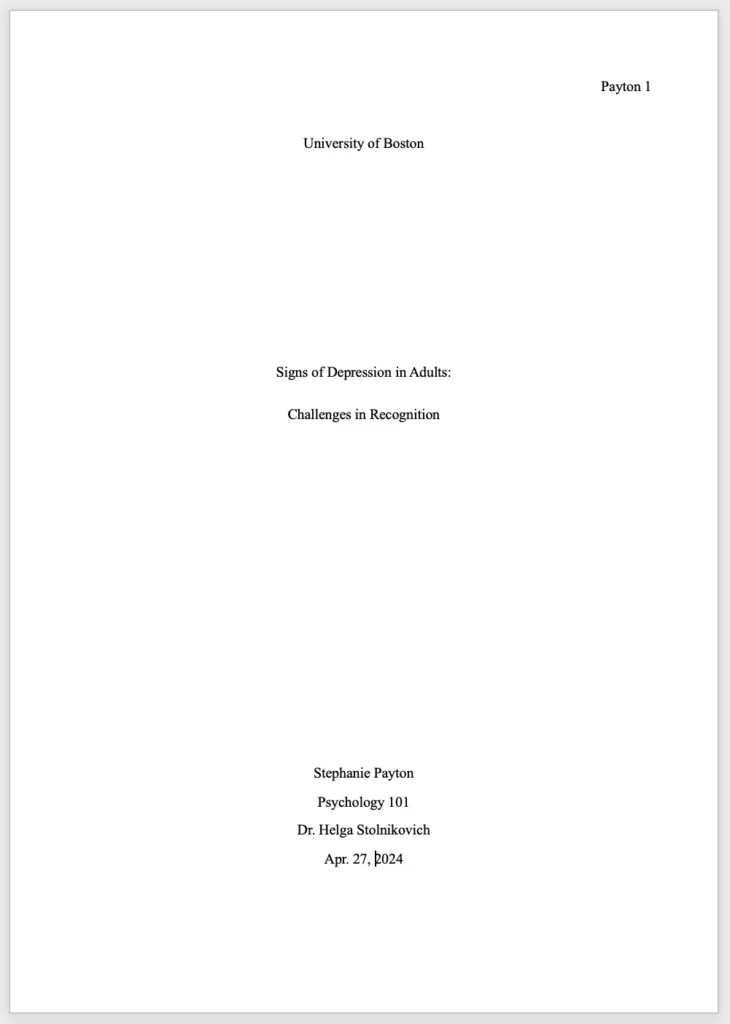How to Make an Essay Cover Page

When things start to get more serious in college, your papers also tend to transform a bit. Term papers, literature reviews, theses – most of them require a cover page. This first page introduces your work before anyone reads the actual content. It usually includes the title of your essay, your name, your class or course name, and the date you’re submitting it. It started as a way to make sure all the necessary details about the essay and its writer were easily accessible. Over time, it became a standard part of academic writing.
A good cover page makes your essay look polished and professional because it shows that you care about your work and are serious about presenting it well. Moreover, it helps teachers and professors organize students’ work and go through it because by looking at the cover page they get to know what the work is about and who the author is.
Why Some Works Require an Essay Cover Page
Some academic works need an essay cover page for several important reasons. Firstly, it helps organize your work and presents key details like the title, author’s name, and date clearly. Secondly, a cover page adds a professional touch, making your work stand out in a stack of papers. It also sets the stage for a polished first impression which is always great.
Here are some types of academic works that usually need a cover page:
- Research papers
- Dissertations
- Theses
- Formal reports
- Project submissions
However, this isn’t a universal list for every institution. You should always check with your professor about specific requirements for your cover page since different teachers might have different preferences or guidelines. Clarifying these details makes sure your cover page meets all necessary standards and helps present your work in the best possible way.
How to Make a Cover Page in Microsoft Word
Creating a cover page in Microsoft Word is simple once you know the steps. Here’s a guide to help you make a professional cover page for your essay.
- Open Microsoft Word: Start by opening Microsoft Word. You can do this by clicking on the Word icon on your desktop or searching for it in your start menu.
- Create a New Document: Click on “File” in the top left corner, then select “New.” Choose “Blank Document” to start with a clean slate.
- Insert a Cover Page: Go to the “Insert” tab on the ribbon at the top of the screen. Click on “Cover Page.” Word offers several pre-designed cover page templates. Choose one that fits your style by clicking on it. The template will automatically insert into your document.
- Customize the Template: Replace the placeholder text with your own information. Typically, you will need to include:
- The title of your essay
- Your name
- Your class or course name
- The date of submission
- Adjust Fonts and Formatting: Ensure that the font style and size match your professor’s requirements. Common choices are Times New Roman or Arial in size 12. To change the font, highlight the text and select the desired font and size from the “Home” tab.
- Check Margins and Spacing: Go to the “Layout” tab and check the margins. The standard margin size is one inch on all sides. Make sure your text is double-spaced. You can adjust spacing in the “Paragraph” section of the “Home” tab.
- Review and Save: Before finishing, review your cover page to ensure all information is correct and neatly formatted. Save your document by clicking “File” and then “Save As.” Choose a location on your computer and give your file a name.
Following these steps and guidelines will help you create a polished cover page that meets academic standards. As you can see, there’s nothing complicated about it!
Essay Cover Page in MLA, APA, and Chicago Styles
Okay, now that we have the basics out of the way, let’s look at some concrete examples of the three most popular citation styles: MLA, APA, and Chicago.
MLA
- Title: Centered, not bold, positioned about a third of the way down the page. Use title case capitalization (capitalize the first letter of each major word).
- Author’s Name: Centered below the title. Include your full name (first name and last name).
- Course Information: Centered below the author’s name. Include the course name and number.
- Instructor’s Name: Centered below the course information. Write the full name of your instructor.
- Date: Centered below the instructor’s name. Write the date of submission in the format Day Month Year (e.g., 27 April 2024).

APA
- Page Header: Include a page number in the top right corner. In the header, include a shortened version of your title, in all caps, aligned to the left (only in student papers if requested by the instructor).
- Title: Centered and bold, positioned about a third of the way down the page. Use title case capitalization (capitalize the first letter of each major word). For title ideas, you can use our Essay Title Generator.
- Author’s Name: Centered below the title. Include your full name (first name, middle initial(s), and last name).
- Institutional Affiliation: Centered below the author’s name. Include the name of your university or institution.
- Course Information: Centered below the institutional affiliation. Include the course number and name.
- Instructor’s Name: Centered below the course information. Write the full name of your instructor.
- Date: Centered below the instructor’s name. Write the date of submission in the format Month, Day, Year.

Chicago
- University Name: Centered at the top of the page. Include the name of your university or institution.
- Title: Centered, bold, positioned about a third of the way down the page. Use title case capitalization (capitalize the first letter of each major word).
- Subtitle (if any): Centered directly below the title. Use title case capitalization and bold.
- Author’s Name: Centered below the title or subtitle. Include your full name (first name and last name).
- Course Information: Centered below the author’s name. Include the course number and name.
- Instructor’s Name: Centered below the course information. Write the full name of your instructor.
- Date: Centered below the instructor’s name.

FAQ
How do you write a good cover page for a paper?
Writing a good cover page for a paper involves including key details and following proper formatting guidelines. Start with a clear, concise title that reflects the content of your paper. Below the title, list your name, the instructor’s name, the course, and the submission date. Make sure everything is centered and use a professional, easy-to-read font. Pay attention to any specific instructions provided by your instructor or the required style guide, such as APA or MLA.
What must a cover page look like?
A cover page should be clean, organized, and professional. It typically includes the title of your paper centered on the page, followed by your name, your instructor’s name, the course title, and the date. Use a standard font, such as Times New Roman or Arial, and keep the text consistently sized. Depending on the formatting style required (APA, MLA, etc.), you may need additional elements like a running head or specific spacing.
What is the best format for a cover page?
The best format for a cover page depends on the required style guide. For APA format, include a running head, page number, title, your name, your institution, the course, instructor’s name, and the date. For MLA format, include the title, your name, the instructor’s name, the course title, and the date, all double-spaced and left-aligned except for the title, which should be centered. Always follow the specific guidelines provided to ensure your cover page meets the necessary standards.





